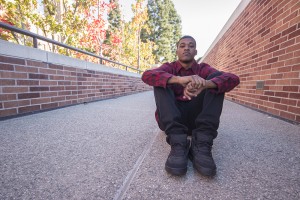At age nine, Terry Gray realized his passion by way of his mother. When Gray’s mom noticed his knack for freestyling at school, she wrote him his first rap.
Now, a fourth-year Afro-American studies student at UCLA, Gray released his first mixtape, “American Paradox,” on Nov. 17.
Gray teased the public with the release of his mixtape with three songs, including “Figueroa R.A.P.,” and “iii’m on.” Gray said the songs explore his life in Los Angeles and his ideas about identity.
Gray discusses the contrast of his hometown in South Central L.A. with UCLA in “iii’m on,” singing, “You only live once/ I’m living double lives.”
“Figueroa R.A.P.” is Gray’s first and most popular song, and has now reached over 40,000 views on YouTube.
Gray’s mixtape also incorporates manystories from his musical past. Gray started writing poetry in his early childhood, which, combined with his love of hip-hop music, organically progressed into rap.
“(In) my household, it was all hip-hop,” Gray said. “It was always a part of my life.”
With a former rapper as a father and classmates who often freestyled at school for fun, Gray said his childhood was very musically charged.
In between taking classes at UCLA, Gray said he made sure to allot time for his songwriting. His mixtape is an amalgamation of the songs he wrote this past year. As a result, “American Paradox” includes songs about Gray’s childhood and adolescence contrasted with life at UCLA.
Some songs from Gray’s mixtape explore his difficulty with fitting in at each phase, in regard to his identity. The mixtape deals with issues Gray faced when he was in South Central L.A., like gangs, contrasted with the new problems he says he faced at college, like being judged in relation to stereotypical ideas of a black man.
In “Figueroa R.A.P.,” Gray sings about how his childhood helped shape his current identity. Parallel to the song, the music video is shot on location on Figueroa Street in L.A., and is interspersed with shots of Gray singing in different locations at UCLA.
Gray sings, “Now I’m a Bruin, you see/ and a lot of things just gotta be said … my penmanship is sending you principles.”

Gray said that coming to UCLA was a significant experience because it was a cultural shock. The diversity, he said, made him want to give the different people – the people he related to – a voice.
“Coming here, it is really diverse. It’s a world the people where I’m from have never seen,” Gray said. “The fact that I have seen so many point of views has helped my raps.”
Mike Leisure, who produced Gray’s music video for “iii’m on,” said he knew he wanted to work with Gray when he saw that his music was both personal and attention-grabbing. Leisure said he knew that Gray was different than most hip-hop artists after listening in on one of his recording sessions last year.
“He’s a very talented and humble guy,” Leisure said. “Somewhat rare nowadays with the type of rappers we normally see.”
Gray said that he did not want to conform to media portrayals of a typical rapper, being overtly fashion-conscious and rowdy, because he wanted to stay true to the diversity he saw in college. He was wary of having a stereotypical identity.
“I try to be myself because I can’t make music I can’t relate to,” Gray said.
Rather than focusing on commercial success, Gray’s main goal, he said, is to make good music that he is proud of and happy with. He thought of creating this mixtape as a personal challenge to see if he could achieve that goal.
“(I wanted to) challenge myself and see if I can really define that (transition),” Gray said. “I defined that as well as I could.”
Keenan Park, who mixed Gray’s singles “Figueroa R.A.P.” and “iii’m on,” said that Gray is very focused on making his music the way he wants it. Park said that Gray often likes to make adjustments to his music, and try out new mixes. Gray often gives Park feedback on the mix, to ensure that the songs reflect the emotions he is trying to convey.
“(Gray is) a talented dude and he’s all about perfecting his craft,” Park said.
Working on this mixtape, Gray said he kept in mind his belief that if one makes one’s music right, it will go where it belongs.
“I don’t do anything until it’s right, and that’s indicative as to why the mixtape is coming out now.”
Gray said that he believes that music is something personal, and he tries to convey that through his work.
“Rap don’t live in a CD,” Gray sings in “Figueroa R.A.P.” “It lives in my bones.”
